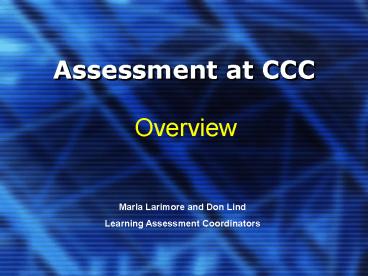Assessment at CCC - PowerPoint PPT Presentation
1 / 41
Title: Assessment at CCC
1
Assessment at CCC
- Overview
Marla Larimore and Don Lind Learning Assessment
Coordinators
2
Phase I Accomplishments
- Launched Capstone course
- Pre-Post Compass
- Faculty attends conference
- Faculty luncheons
- Faculty Seminars
- Develop custom software
- Development of rubrics
- Assessment newsletter
3
Phase II Accomplishments
- Faculty identified their Fall 05 Sp 06 data by
Type. - Faculty processed their data sent
commentary forms to Division Chairs.. - Division Chair Templates were sent to LAC
- Area Reports were processed for Deans
4
Important Terms
MASTERY
GAINS
INTERVENTION
5
MASTERY
Over all Achievement or Completion Level
6
GAINS
The relative amount of learning achieved
7
Comparing Students
START 30 .. END 72
GAIN 43 Mastery
72
START 70 .. END 85
GAIN 15 Mastery
85
8
Intervention
911
9
This Is Your Assignment!
No Excuses!!!
10
Required Components
Learning Gains
11
Required Components
FEEDBACK
12
Another Requirement
DOCUMENTATION
13
How to Type Your Data
What kind of data did you collect?
If you simply gave a pre/post test, averaged the
scores without referencing student names or
learning outcomes then you have a
TYPE 1 DATA
14
Typing Your Data
If you gave a pre and post exam and Recorded how
many of each outcome-related Items were answered
correctly (Mapping) then your data would be
TYPE 2 DATA
15
But What If You
- Gave a pre/post exam.
- Determine how many of each outcome-related items
were correct. - And did this for each individual student?
- Then you would have
TYPE 3 DATA
16
TYPE 1 CONCEPTS
17
What Can Type 1 Data Reveal?
60
82
PRE
POST
18
A Look at the Data
- Pre 60 Post 82
- Average class Mastery of 82
- Average class Gains of 22
- Were scores similar or varied?
- Compare to other sections of this class taught
this semester. - Compare to other section of this class taught
other semesters.
19
(No Transcript)
20
TYPE 2 CONCEPTS
21
Type 2 Analysis
- The primary goals of a Type 2 Analysis are
- To measure Learning Gains
- To note what content was best learned.
- To note what content was least learned.
- To consider possible changes
22
(No Transcript)
23
31
24
A Look at the Data
- Pre 34.5 Post 59.75
- Average class Mastery of 59.75
- Average class Gains of 31. or (25.25)
- 4 of the outcomes were at or above 31.
- 3 of the outcomes were below 31.
- Take special note of the outcomes which were
poorly achieved. - Document your thoughts on these results.
25
Food for Thought
A Type 2 Analysis automatically includes any
thing a Type 1 would have revealed.
Instead of running both, do a Type 2 and spend a
little more time in your interpretation of the
results
26
TYPE 3 CONCEPTS
27
TYPE 3C TYPE 3P ?
- How do they differ?
- Type 3C explores just one course at a time.
- Type 3C is an EXCEL template.
- Type 3P explores multiples courses at once.
- Type 3P is an ACCESS application.
- Type 3P is designed for Technical Programs.
28
Type 3 Analysis
- The primary goals of a Type 3 Analysis are
- To measure Learning Gains
- To note what content was best learned as well as
least. - To provide individual student records for
Technical Occupational programs. - To assist not only in assessment activities but
also in Carl Perkins reports.
29
Listing of Outcomes
30
Enter PRE Test Scores
31
Enter POST Test Scores
32
Average GAINS
33
GAINS ANALYSIS
34
A Look at the Data
- Take special note of the outcomes which were
poorly achieved. - Note the performance of each student.
- Archive results for at least 3 years.
- Consider carefully what happened in this course
and if any changes are in order. - Document your thoughts on these results.
35
Food for Thought
A Type 3 Analysis automatically includes any
thing a Type 2 would have revealed.
Instead of running both, do a Type 3 and spend a
little more time in your interpretation of the
results
36
How Do I Report This Data?
77
75
PRE
POST
37
Reporting Negative Gains
Pre 77 and Post 75
Gain of zero
Use higher score for mastery
You might want to comment on the pre post test
instruments as to whether or not they may be
faulty
38
What About Missing Scores?
- Some students never take the pre-test.
- Some students exit before taking the post-test.
- This is up to the instructor, normally we throw
out all incomplete student data. - Obviously the gains require that we use
paired data.
39
Who Should do a Type 3P?
All formal Technical programs should be doing a
Type 3P Analysis, starting with at least one or
two at the outset.
Occupational programs should consider doing at
least one of their programs each semester as a
Type 3P activity.
40
Winding Up ..
41
What If I am Still Uncertain?
- Please do not hesitate to contact
- Marla Larimore or
- Don Lind
- Wed be happy to assist you in any way!
Thanks for attending this session!































